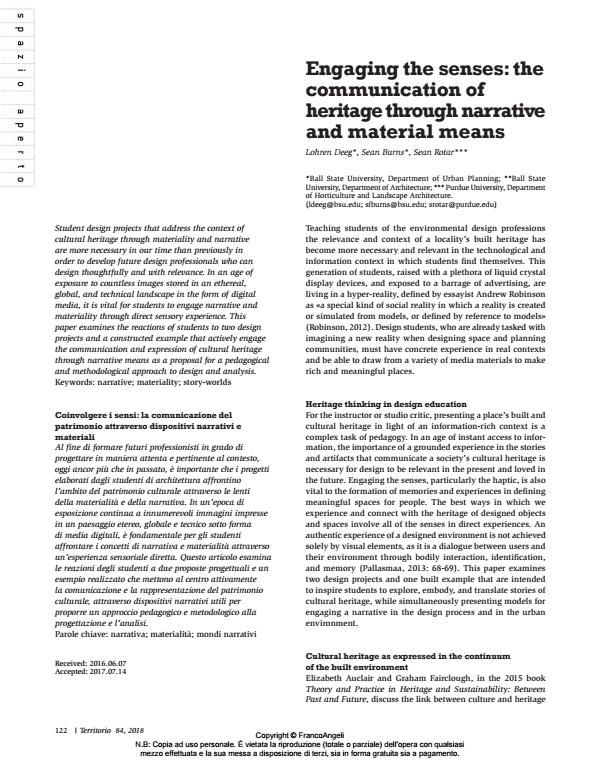Engaging the senses: the communication of heritage through narrative and material means
Journal title TERRITORIO
Author/s Lohren Deeg, Sean Burns, Sean Rotar
Publishing Year 2018 Issue 2018/84
Language English Pages 6 P. 122-127 File size 353 KB
DOI 10.3280/TR2018-084018
DOI is like a bar code for intellectual property: to have more infomation
click here
Below, you can see the article first page
If you want to buy this article in PDF format, you can do it, following the instructions to buy download credits

FrancoAngeli is member of Publishers International Linking Association, Inc (PILA), a not-for-profit association which run the CrossRef service enabling links to and from online scholarly content.
Student design projects that address the context of cultural heritage through materiality and narrative are more necessary in our time than previously in order to develop future design professionals who can design thoughtfully and with relevance. In an age of exposure to countless images stored in an ethereal, global, and technical landscape in the form of digital media, it is vital for students to engage narrative and materiality through direct sensory experience. This paper examines the reactions of students to two design projects and a constructed example that actively engage the communication and expression of cultural heritage through narrative means as a proposal for a pedagogical and methodological approach to design and analysis.
Keywords: Narrative; materiality; story-worlds
- Adamson G., 2007, Thinking through craft. Oxford: Berg.
- Auclair E., Fairclough G., 2015, «Living between past and future». In: In theory and practice in heritage and sustainability: Between past and future. New York, NY: Routledge, 1-20.
- Baum K., 2015, February 25, Reflections on bridge project [e-mail to S. Burns].
- Deeg L., Rotar S., Burns, S., 2015, «The persistence of the senses: Materiality, precedent and narrative in communicating heritage». In: Kępczyńska-Walczak A. (ed.), Envisioning architecture: Image, perception and communication of heritage. Lodz: Lodz University of Technology, 338-347.
- Herman D., 2009, «Narrative ways of worldmaking». In: Heinen S., Sommer R. (eds.), Narratologia. Narratology in the age of cross-disciplinary narrative research contributions to narrative theory, 71-87. DOI: 10.1515/9783110222432.71
- Kanekar A., 2015, Architecture's pretexts: Spaces of translation. New York, NY: Routledge.
- Pallasmaa J., 2013, The eyes of the skin: Architecture and the senses. Chichester: Wiley-Academy.
- Robinson A., 2012, August 10, Jean Baudrillard: Hyperreality and implosion. https://ceasefiremagazine.co.uk/in-theory-baudrillard-9/ (accessed on 2018.03.01).
- Ryan M., Thon J., 2014, Storyworlds across media: Toward a media-conscious narratology. Lincoln, NE: University of Nebraska Press.
- Voigt J., 2015, March 2, Reflections on painting project [e-mail to L. Deeg]
Lohren Deeg, Sean Burns, Sean Rotar, Engaging the senses: the communication of heritage through narrative and material means in "TERRITORIO" 84/2018, pp 122-127, DOI: 10.3280/TR2018-084018